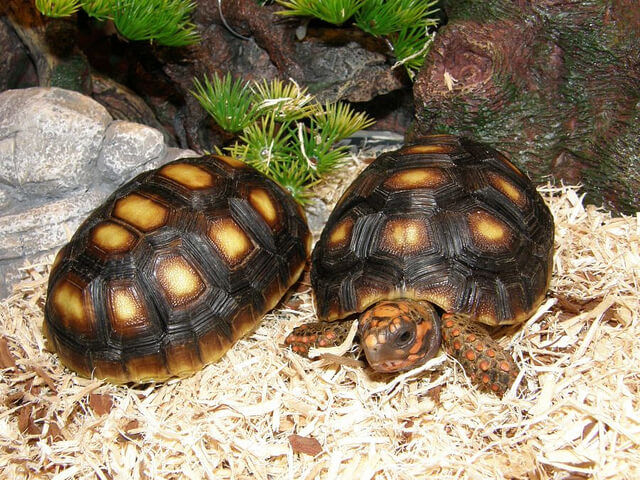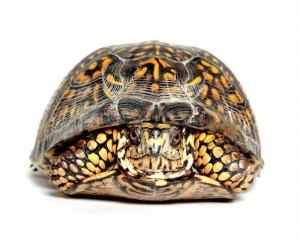Turtle Hibernation Brumation and Estivation
Turtles in their natural habitat will hibernate if their given climate gets cold during the winter months. When the outdoor temperatures drop, the days get shorter and the sun sits lower in the sky, turtles and tortoises will begin to prepare for a period of hibernation. Technically this period for turtles is call brumation but for readability, we will use the term “hibernation”.
Table of Contents
Related Content:
Turtles are cold blooded animals and when it gets too cold, they have a difficulty moving their limbs and digesting their food. In combination with these factors and the fact that there often isn’t as much food available durning the winter months, it only makes sense for them to find a safe quiet place to live out the winter. These safe quiet places usually involves a dugout burrow that gets them below the frost line or under a thick bed of rotting leaves.
On the other extreme, some desert tortoise, box turtles and aquatic turtles will go into a period of dormancy during times of extreme temperatures. In essence, this is for the same reasons that some turtles hibernate; which is, survival. During hot dry spells, it’s important that these chelonians escape these extreme temperatures by burrowing into the ground or hiding under leaves, bushes or logs where the environment is much cooler. If a tortoise or turtle, especially an aquatic turtle is expose to long periods of drought and heat, they can dry out and die (Desiccation). For this reason, you should always provide some sort of cover or escape in your outdoor turtle and tortoise pens.
Definitions
- Hibernation: Hibernation is the process of inactivity (sleeping) during an extended period of time when an animal has a lower body temperature, slower breathing and conserves food by living off fat deposits.
- Brumation: Brumation is the process of when reptiles slow down during cold temperatures. They stop eating and become inactive. It’s different from hibernation in that during brumaiton, the reptiles are not technically in a sleeping state but rather have a slowed down metabolism that requires them to eat less.
- Estivation: Estivation or Aestivation is the process of inactivity or dormancy during periods of extreme temperatures in which their metabolic rate is lowered. This activity is to help avoid the animal from drying out.
To Hibernate or Not?
Some turtles and tortoise species hibernate while others do not. Tropical tortoises like the Red Footed tortoise and Asian box turtle species such as the Malayan and Keeled don’t. Many of the box turtles that originate from the South Eastern United States, are used to much shorter cold periods and thus don’t hibernate as long or start later. Understanding what type of turtle you have will help you determine if and when it is time to put them into hibernation. It’s healthy to hibernate them so you should if they are ready and able.

Requirement for Hibernation
- The Temperature is close to 50*F/10*c (Usually starting around Sept-Oct)
- They are healthy and no signs of illness or disease:
- No swelling on the head or ear infections
- No open wounds that need to heal
- No dry or flaky skin (vitamin deficiency)
- No discharge from eyes nose or mouth
- No swollen or shut eyes
- No white or light colored tongue
- They are not young juveniles, less than a few years old
- You have a safe and secure location to hibernate them

Preparing Your Turtles
Towards the end of the Summer, add more greens that include vitamin A or a cod liver oil supplement into your turtle’s diet. Only a few drop of the oil is needed during the entire month because vitamin A is fat soluble and will stay in your turtle’s system throughout winter. As you begin to recognize your turtle slowing down, decreasing its food intake and attempting to dig a burrow, you will know it’s time to prepare them for hibernation. At this point you should stop feeding them and allow them to soak daily so they can clear out their digestive tract. Food left in the stomach and intestine can rot and lead to health problems. Right before you place them away for the winter, soak them one last time and inspect them for illness.
Outdoors
Turtles in the wild hibernate outside so your pet turtles can survive outside too; given you live in a climate that is similar to their own. However, it’s not as easy to checkup on them and make sure they are healthy. It also leaves them open to predators and pests. If you do decide to keep them outside, make sure you secure the hibernation chamber so predators can’t get to them. You do this by digging a pit into the ground that is about two to three feet deep and two feet across. Make sure it’s not dug into an area that is prone to flooding. Next fill the pit with mulch, moss, and grass clippings and them moisten it with hose. Once you place the turtles into the pit, allow them to dig down before placing additional leaves and mulch on top of them. For added protection, add a piece of plywood on top of the pit raised up by a few bricks. This will keep the rain out and predators away.
Indoors
It’s easier and safer to hibernate turtles and tortoises indoors. Well in a garage, shed or barn that has electricity. This method allows you to control the temperatures and make sure they are doing okay. You can build a box or use a storage bin to use as a hibernation tank. Inside these containers, fill them with styrofoam peanuts or another packaging material. Then place another box inside all of that. Inside this interior box, add shredded paper or a loose substrate. Finally, place a turtle inside that box and loosely close both lids. You don’t want it air tight otherwise they would suffocate. You might want to add a few ventilation holes in both boxes. Place this box on a shelf or on a few pieces of insulation board to raise it off the cold floor and keep bugs out.
Refrigerator
Box turtles that are kept inside should not be allowed to hibernate inside a heated home. The temperatures are not cold enough and they will never go into a state of torpor. You can either use the method or use a refrigerator set to 45-50*F. Place a container inside your spare fridge with a layer of substrate. Place a lid with ventilation holes on top of this container. You can then monitor the temperature of the refrigerator to ensure it is the ideal temp (get a quality thermometer to place inside. By opening the door once a day should be enough to provide fresh oxygen for them. If you have a fridge with multiple turtles, consider drilling a small hole or two in the top of the door. The cold air will settle on the bottom so place your turtles on the bottom shelves.

Routine Checkups During
Weigh all turtles periodically to ensure they are not losing an excessive amount of weight. Turtles should lose more than 10% of their weight during hibernation. If any of them have lost too much weight, you should take them out of hibernation and over winter them inside a in a turtle tank. Warm them up slowly over the course of a week. For the first month, you can take them out and soak them in tepid water every other week and then again in early spring. Between those periods, you can check them once a month.
Waking them Up when it’s Time
When night temperatures get above 50*F and day time temps are in the 60s, turtles will begin to emerge from hibernation chambers. In the wild they will hibernate from October to March but you can bring them out of hibernation sooner if you can provide them summer like conditions using heaters and lights. Turtles that have been the refrigerator should only be allowed to hibernate for three month. You can take them out of hibernation by slowly raising the temp of the fridge over a week or so.
Turtles will likely not eat right after they wake up but you need to provide them with fresh water daily. If yo notice any of your turtles are underweight, you should try to get them to eat sooner. Finally you should inspect them for diseases and illnesses and treat any health issues right away.

Reviewed By: Tim Winter

Tim Winter has a strong affection for pets and wildlife. His years of experience caring for various types of pets has led him to share his knowledge with others on the best practices in pet care. Tim holds a Bachelor of Science from the University of Oregon School of Journalism and Communications.

I found a baby male snapping turtle in my basement sump well, got him inside now, food offered but not eating well, he’s moving but slowly, it’s late October and wondering if he’s going into hibernation, it’s not my first turtle, but I’m concerned about his natural instinct to hibernate.
We live in the Houston area, where it dips into cold weather but doesn’t consistently stay cold… our turtle is in a 1200 gallon pond outside right now, and I’m wondering whether I should try to heat the pond a little during the few nights it freezes, or whether I should just let her slow down and not have the water temp be too different than the air temp. Thanks!
For how long cá na tutele aestivate?
My Ester turtle disappeared almost 3 months ago in a large property and I ‘m site she burried itself because she tried to do it the das before. She esse used being at home vedores that. Her companion tried to do the same but ee found him. It was july and quite hot. I took my eyes from her for 30 minutes and never found her again..,
Will she come out on its own? When?
Thank you.
Hi I have an indoor aquatic turtle in a tank, heated, filtered , UV lighting, Basking light
He is on a natural diet , fish, yabby, worms , aquatic plant – Val & duck weed
He is showing signs of brumation , slower & not interacting so much with me through the glass, he is eating sometimes & sometimes not interested
What is your suggestion for feeding during this time ?as I am so use to the routine of regular feeding ..fish every 4 days, yabby (not whole one)once a week, plant 3 out of 4 days a week, Also Nutrifin Turtle pellets for vitamins .
Regards Kim
If they hibernate , how do we know that they are not dead ?
Their metabolism and movement is slowed, but they are not unconscious. They are awake and aware of their surroundings, so they should respond to you in some way. And if they’re dead, I would assume there would be an odor….